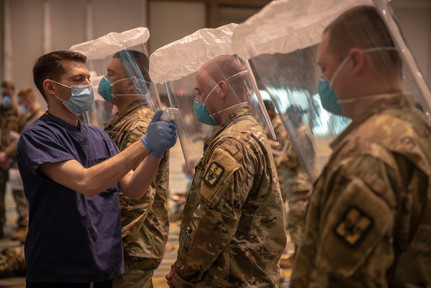The rise of the COVID-19 pandemic has threatened to overwhelm health systems across the United States, prompting states to quickly build additional medical capacity. One solution has been to create temporary care centers, which can support local medical systems and increase state and local medical capacity to provide care to patients infected with SARS-CoV-2 (the disease which causes COVID-19 illness).
Lieutenant commander Danny Malashock, MS, REHS, a doctoral student in the Department of Environmental and Occupational Health at the George Washington University Milken Institute School of Public Health (Milken Institute SPH), was part of a U.S. Public Health Service (USPHS) team that deployed to the TCF Regional Care Center in Detroit, Michigan. There, Malashock provided support at the state’s first care site for patients infected with COVID-19.
“I served as the team’s lead safety officer for the medical operation at the TCF and was responsible for all matters related to safety, including infection control, preventative medicine, and personal protective equipment protocols,” Malashock said. “Implementing and maintaining the infection control program was critical to ensure clinical staff was safe from transmission of the illness. There were 500 additional responders from the state of Michigan and other uniform services, and many had not worked together before. It required a great deal of coordination to make sure everyone could work together safely.”
While at the TCF, Malashock described encountering challenges related to educating the public about COVID-19. He found that patients, their loved ones, and his fellow responders needed more education about the novel coronavirus and help understanding what information was credible.
“All COVID-related public health work is somehow related to communicating risks and putting often-complex public health metrics into language that is tangible to everyone,” Malashock said. “In my experience at TCF, I found that people were eager to learn more about ways to prevent transmission of the virus and really appreciated our efforts to explain the rationale behind why certain protocols or recommendations were being issued by the government.”
In addition to his role as an Environmental Health Officer at the USPHS, Malashock works as an Environmental Health Scientist advancing indoor air quality science and public health guidance in the Office of Radiation and Indoor Air at the US Environmental Protection Agency.
A short video, titled “The Faces Behind the Masks,” commemorates the USPHS deployment to the TCF Regional Care Center. The video can be found here.


